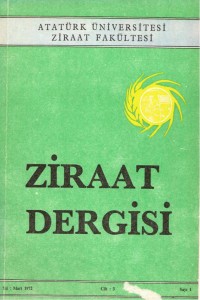ERZİNCAN OVASI TOPRAK VE SU KAYNAKLARININ SULAMA YÖNüNDEN PROBLEMLERİ VE GELİŞTİRİLME İMKANLARI ÜZERİNDE BİR ARAŞTIRMA
Öz
ÖZET
Bu çalışmada, Erzincan Ovası topraklarının sulama yönünden önemli
karekterleri incelenmiş ve bölgede tatbik edilen sulama metodları
tespit edilmiştir. Bilhassa drenaj problemlerinin mevcut olduğu kısımlarda
ıslatılması gereken toprak derinliği tespit edilmeye çalışılmıştır.
Sulamada kullanılan su kaynaklarının sulamaya elverişlilik yönünden
Jln!flandınlmaları yapılmış ve sulama tatbikatlarında emniyetle kullanılıp
kullanılmayacağı tayin edilmiştir. Ovada uygulanan bitki paterni
gözönünde bulundurularak, her bitkinin aylık ve mevsimlik su tüketimi
hesaplanmış, daha sonra randımanlar da dikkate alınarak ovanın toplam
sulama suyu ihtiyacı hesaplanmıştır.
A RESEARCH ON THE PROBLEMS AND lMPROVEMENT POSSIBILITIES OF SOIL-WATERRESOURCES OF ERZİNCAN VALLEY FOR IRRIGATION.
The goal of this research is to
study soil-water relations and to help
use of present soil and water resources
more productively. For this purpose
soil charecteristics of these soils which
are important for irrigation purposes
and quality of irrigation water and water
requirement of vaUey are investigated
and advices are given to take
necassary measurements.
The result of the research carried
out on irrigation and soils of Erzincan
vaUey can be summarized as below:
1- The irrigation project of Erzincan
valley is planned of irrigate
8250 hectares of irrigable lan.d of
27437 hectares, At present day, the completed
project encloses only 7 000 hectares
of land; but today only % 70
of this area is irrigated.
The main course of the low-irrigation
achievement is largely the result
of farmer's lack of experience in irrigation
practice and the lack of orga
nizatİon.
As a result of farmer's lack of
experience in irrigation; the irrigation
field efficieny of the existing' irrigation;
the irrigation field effiviency
o f the existing irrigation system as low
% 32 to % 58.
2- The investigated soils of Erzincan
valley are mainly loamy soils. The
soil profites show differential layers.
in general, the investigated soils are
satisfactory for plant growth and in
water holding capacity,
3- The particıe density of soils
vary from, 2,22 to 2,95 and bulk density
from 0,73 gr/cm 3 to 1,79 gr/cm3. The
great variation in bulk density is due
to soils layers.
4· The porosity of ınvestigated
soils is varying along the layers of soil
profHes and have the value of % 27,16
to % 70,17.
5- The total porosity of soils consist
of % 0,5 - %43,20 large (non capillar),
% 7,71 - % 81,10 middle and
% 5,20 - % 72,23 tight or confined capillar.
The distribution of porosity
shows that, the investigated soils have
a low air capaçity. In the view of this
fact, these soils should be irrigated
with care, so that the aif capacity of
the soils maintained at at favourable
level to the plant roots
6- The hydraulil! conductivity of
the searched soils is varying with respect
to the non cappillar porosity,
from 0.02 cm/holl! to 23,20 cm/hour.
7- The constant intake rate of the
soils range from 0,5 cm/hour to 50,2
cm/hour.
With respect to the intake rate,
the investigated soils mostly fall into
"high" infiltration class.
The accumulated infiltratioI1 (y)
is expressed in the from of, y = a.tıı
The constant (a) and (n) in this equation
varies in a wide range.
8- The retention of water by soils
varies with layers of soil profites in a
great variation.
With respect to the moisture retention,
there exist a correlation between
dayand silt content of soils.
in general, the water holding capacity
of the investigated soils are bigh.
But soils that have a high percentage
of day, also have a available moisture
high wilting percentage and thus a low
range.
9- For the first 60 cm depth of SO~
il profiles; the moisture range between
field capaeity and permanent
wilting percentage vary from 3,3 cm
to 15,2 cm.
10- For the [irst 60 cm depth of
soi1s of searched area, time required
to bring the moisture content of soils
from wi1ting percentage to the field
capacity vary from 0,25 hours 10,75
hours.
11- For a uDifoem water distrubition
in the soils, irrigation water should
reach to the end of the furrows in
1{4 of the time required to WL the root
zone of he plants.
Wjth respect to the above fact;
the calculated time, in which the irrigation
water to reaeh the end of furrows
varies from 0,06 hours to 2,68
hours.
12- In the searched area, where
drainage proleıns exist, the ground
water table is about 20 em belaw the
surface.
13- The water used for irrigation
in the investigated area, is classified
as CıS ı and C2SI'
14- The irrigable land of the İnvestigated
area is abont 27 437 hectares
with a rotatian fitting the existing condition
in the area, the fol1owing plant
pattem can be espected :
Small grain % 45,2; sugarbeet
% 25,4; vegetable % 12,7; forage plant
% 8,8'; orehards % 3,4; potatoes
% 2'6 and dry beans % 2.0 of the irrigable
land.
The irrigation water requirement,
caleulated by the Blaney-Criddle Method;
is for smaIl grain 371,5; for sugarbeet
686,2; for vegetables 415,7;
for forage plant 642,5 m.'11 and for orchards
562,9 mm.
Taking the proposed plant rotation
into consideration, the estimated
seasonal irrigation requirement of the
investigated area is about 1091,5 mm
(based on in irrigation field effeeiency
of % 45) The caıCulated peak demand
of the irrigation requirement of the
area is 350,2 mm in Jluly.
if the irrigation water is conveyed
by lined ehannels the above amount
will rise to 4LO and if water conveyed
by earth channels it would be
about 500,3 mm.
Anahtar Kelimeler
Ayrıntılar
| Birincil Dil | tr;en |
|---|---|
| Bölüm | ARAŞTIRMALAR |
| Yazarlar | |
| Yayımlanma Tarihi | 11 Aralık 2010 |
| Yayımlandığı Sayı | Yıl 1972 Cilt: 3 Sayı: 1 |
Kaynak Göster
Bu dergide yayınlanan makaleler Creative Commons Uluslararası Lisansı (https://creativecommons.org/licenses/by-nc/4.0/) kapsamında yayınlanmaktadır. Bu, orijinal makaleye uygun şekilde atıf yapılması şartıyla, eserin herhangi bir ortam veya formatta kopyalanmasını ve dağıtılmasını sağlar. Ancak, eserler ticari amaçlar için kullanılamaz.
https://creativecommons.org/licenses/by-nc/4.0/


